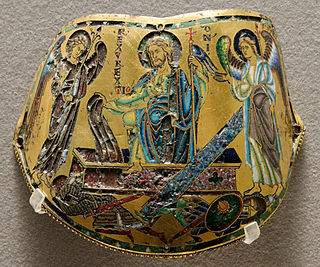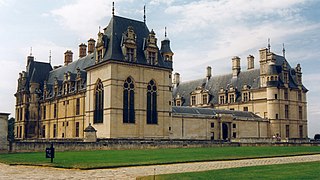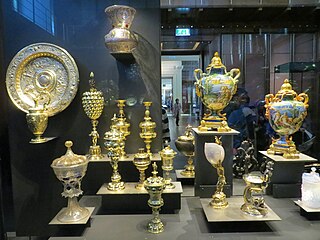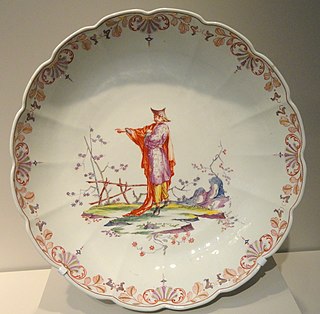
Thomas Gainsborough was an English portrait and landscape painter, draughtsman, and printmaker. Along with his rival Sir Joshua Reynolds, he is considered one of the most important British artists of the second half of the 18th century. He painted quickly, and the works of his maturity are characterised by a light palette and easy strokes. Despite being a prolific portrait painter, Gainsborough gained greater satisfaction from his landscapes. He is credited as the originator of the 18th-century British landscape school. Gainsborough was a founding member of the Royal Academy.

Vitreous enamel, also called porcelain enamel, is a material made by fusing powdered glass to a substrate by firing, usually between 750 and 850 °C. The powder melts, flows, and then hardens to a smooth, durable vitreous coating. The word vitreous comes from the Latin vitreus, meaning "glassy".

Waddesdon Manor is a country house in the village of Waddesdon, in Buckinghamshire, England. Owned by the National Trust and managed by the Rothschild Foundation, it is one of the National Trust's most visited properties, with over 463,000 visitors in 2019.

Jean-Henri Riesener was a famous German ébéniste (cabinetmaker), working in Paris, whose work exemplified the early neoclassical "Louis XVI style".

In art history, the French term objet d’art describes an ornamental work of art, and the term objets d’art describes a range of works of art, usually small and three-dimensional, made of high-quality materials, and a finely-rendered finish that emphasises the aesthetics of the artefact. Artists create and produce objets d’art in the fields of the decorative arts and metalwork, porcelain and vitreous enamel; figurines, plaquettes, and engraved gems; ivory carvings and semi-precious hardstone carvings; tapestries, antiques, and antiquities; and books with fine bookbinding.

The Vincennes porcelain manufactory was established in 1740 in the disused royal Château de Vincennes, in Vincennes, east of Paris, which was from the start the main market for its wares.

The Manufacture nationale de Sèvres is one of the principal European porcelain factories. It is located in Sèvres, Hauts-de-Seine, France. It is the continuation of Vincennes porcelain, founded in 1740, which moved to Sèvres in 1756. It has been owned by the French crown or government since 1759.

Champlevé is an enamelling technique in the decorative arts, or an object made by that process, in which troughs or cells are carved, etched, die struck, or cast into the surface of a metal object, and filled with vitreous enamel. The piece is then fired until the enamel fuses, and when cooled the surface of the object is polished. The uncarved portions of the original surface remain visible as a frame for the enamel designs; typically they are gilded in medieval work. The name comes from the French for "raised field", "field" meaning background, though the technique in practice lowers the area to be enamelled rather than raising the rest of the surface.

The Château d'Écouen is an historic château in the commune of Écouen, some 20 km north of Paris, France, and a notable example of French Renaissance architecture. Since 1975, it has housed the collections of the Musée national de la Renaissance.

Northern Mannerism is the form of Mannerism found in the visual arts north of the Alps in the 16th and early 17th centuries. Styles largely derived from Italian Mannerism were found in the Netherlands and elsewhere from around the mid-century, especially Mannerist ornament in architecture; this article concentrates on those times and places where Northern Mannerism generated its most original and distinctive work.

French porcelain has a history spanning a period from the 17th century to the present. The French were heavily involved in the early European efforts to discover the secrets of making the hard-paste porcelain known from Chinese and Japanese export porcelain. They succeeded in developing soft-paste porcelain, but Meissen porcelain was the first to make true hard-paste, around 1710, and the French took over 50 years to catch up with Meissen and the other German factories.

Limoges enamel has been produced at Limoges, in south-western France, over several centuries up to the present. There are two periods when it was of European importance. From the 12th century to 1370 there was a large industry producing metal objects decorated in enamel using the champlevé technique, of which most of the survivals, and probably most of the original production, are religious objects such as reliquaries.

A chasse, châsse or box reliquary is a shape commonly used in medieval metalwork for reliquaries and other containers. To the modern eye the form resembles a house, though a tomb or church was more the intention, with an oblong base, straight sides and two sloping top faces meeting at a central ridge, often marked by a raised strip and decoration. From the sides there are therefore triangular "gable" areas.
Jean de Court used painted Limoges enamel and oil painting, and served as official portrait painter to the monarchs of Scotland and France. The de Court dynasty of enamel painters ran a workshop making Limoges enamel over several generations in Limoges in south-western France.

In 1898 Baron Ferdinand de Rothschild bequeathed to the British Museum as the Waddesdon Bequest the contents from his New Smoking Room at Waddesdon Manor. This consisted of a wide-ranging collection of almost 300 objets d'art et de vertu, which included exquisite examples of jewellery, plate, enamel, carvings, glass and maiolica. One of the earlier objects is the outstanding Holy Thorn Reliquary, probably created in the 1390s in Paris for John, Duke of Berry. The collection is in the tradition of a schatzkammer, or treasure house, such as those formed by the Renaissance princes of Europe; indeed, the majority of the objects are from late Renaissance Europe, although there are several important medieval pieces, and outliers from classical antiquity and medieval Syria.

Pot pourri à vaisseau or pot pourri en navire is the shape used for a number of pot-pourri vases in the form of masted ships, first produced between the late 1750s to the early 1760s by the Sèvres manufactory near Paris. The colours and details of the painted decoration vary between examples, as is typical of Sèvres porcelain, and one example is on a later gilt wood stand. The openwork lid lifts off to allow refilling of the pot-pourri. The shape was eventually produced in two or three versions, at slightly different sizes. It was first designed in 1757, probably by Jean-Claude Duplessis, the artistic director of the factory. The first surviving finished example dates to 1759. Another name for them is vaisseau à mat.

Vienna porcelain is the product of the Vienna Porcelain Manufactory, a porcelain manufacturer in Alsergrund in Vienna, Austria. It was founded in 1718 and continued until 1864.

Enamelled glass or painted glass is glass which has been decorated with vitreous enamel and then fired to fuse the glasses. It can produce brilliant and long-lasting colours, and be translucent or opaque. Unlike most methods of decorating glass, it allows painting using several colours, and along with glass engraving, has historically been the main technique used to create the full range of image types on glass.

The Spitzer Cross is an enameled metal crucifix, made c.1190 in Limoges, in France, by an artisan known as the "Master of the Royal Plantagenet Workshop", and now held by the Cleveland Museum of Art. The work is made from copper, engraved and gilded, and inlaid with champlevé Limoges enamel, depicting Christ on the cross in tones of blue, green, yellow, red and white. It may have been made as a processional cross for the Abbey of Grandmont: similar Limoges enamel crosses are held in other public collections, including the Metropolitan Museum of Art and the British Museum.
Camille Fauré (1874–1956) was a French enamel artist best known for his design work for the Limoges porcelain company in Limoges. Floral and figurative patterns in richly glazed colours were his signature.




















